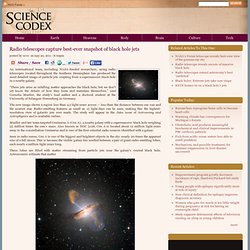

Radio telescopes capture best-ever snapshot of black hole jets. An international team, including NASA-funded researchers, using radio telescopes located throughout the Southern Hemisphere has produced the most detailed image of particle jets erupting from a supermassive black hole in a nearby galaxy.

"These jets arise as infalling matter approaches the black hole, but we don't yet know the details of how they form and maintain themselves," said Cornelia Mueller, the study's lead author and a doctoral student at the University of Erlangen-Nuremberg in Germany. The new image shows a region less than 4.2 light-years across -- less than the distance between our sun and the nearest star. Radio-emitting features as small as 15 light-days can be seen, making this the highest-resolution view of galactic jets ever made.
The study will appear in the June issue of Astronomy and Astrophysics and is available online. Mueller and her team targeted Centaurus A (Cen A), a nearby galaxy with a supermassive black hole weighing 55 million times the sun's mass. Massive 18 new planets discovered. Using twin telescopes at the Keck Observatory in Hawaii, astronomers have discovered 18 new Jupiter-like planets orbiting massive stars.

Researchers at the California Institute of Technology (Caltech), surveyed about 300 stars, and focussed on those dubbed “retired” A-type stars that are more than one and a half times more massive than the sun. These stars are just past the main stage of their life hence, “retired”, and are now puffing up into what’s called a subgiant star. “It’s the largest single announcement of planets in orbit around stars more massive than the sun, aside from the discoveries made by the Kepler mission,” John Johnson, first author on the paper, said.
The Kepler mission is a space telescope that has so far identified more than 1,200 possible planets, though the majority of those have not yet been confirmed. To look for planets, the astronomers searched for stars of this type that wobble, which could be caused by the gravitational tug of an orbiting planet. Black Hole Holds Universe’s Biggest Water Supply. By Mark Brown, Wired UK Two teams of astronomers have discovered the largest and farthest reservoir of water ever found in the universe.

It’s 12 billion light years away, and holds at least 140 trillion times the amount of water in all the Earth’s oceans combined. [partner id="wireduk" align="right"]It manifests itself as a colossal mass of water vapor, hidden in the distant APM 08279+5255 quasar. Quasars are bright and violent galactic nuclei fueled by a supermassive black hole at their center.
This quasar holds a black hole that’s 20 billion times more massive than the sun, and after gobbling down dust and gas it belches out as much energy as a thousand trillion suns. “The environment around this quasar is unique in that it’s producing this huge mass of water,” says Matt Bradford from NASA’s Jet Propulsion Laboratory in a press release.
“It’s another demonstration that water is pervasive throughout the universe, even at the very earliest times,” adds Bradford in the release. See Also: